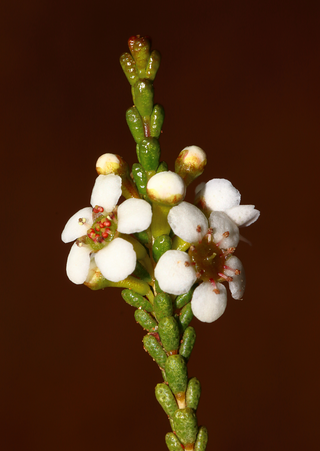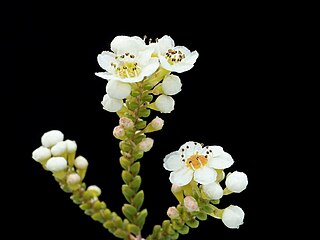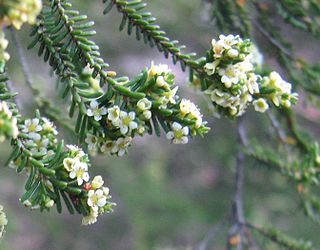
Micromyrtus ciliata is a species of flowering plant in the family Myrtaceae and is endemic to south-eastern continental Australia. It is a spreading to erect shrub with crowded, oblong to egg-shaped leaves and small white or pink flowers arranged singly in upper leaf axils, forming clusters on the ends of branches.
Hypocalymma minus is a species of flowering plant in the myrtle family Myrtaceae, and is endemic to the south west of Western Australia. It is a low-growing shrub, with heart-shaped leaves arranged in opposite pairs, white or pale pink flowers usually arranged singly in leaf axils with 10 to 20 stamens in one or two rows.
Micromyrtus acuta is a species of flowering plant in the myrtle family, Myrtaceae and is endemic to the southwest of Western Australia. It is an erect shrub with small, oblong leaves and small white flowers in the upper leaf axils.
Micromyrtus arenicola is a species of flowering plant in the myrtle family, Myrtaceae and is endemic to a small area in the southwest of Western Australia. It is an erect shrub with small, linear to narrowly egg-shaped leaves and small white flowers.
Micromyrtus barbata is a species of flowering plant in the family Myrtaceae and is endemic to inland areas of Western Australia. It is a shrub with small, overlapping, narrowly egg-shaped leaves and small white flowers arranged singly in upper leaf axils.

Micromyrtus clavata is a species of flowering plant in the family Myrtaceae and is endemic to inland Western Australia. It is an erect, compact or sprawling shrub with erect, egg-shaped leaves with the narrower end towards the base and small white flowers arranged singly in upper leaf axils.
Micromyrtus collina is a species of flowering plant in the myrtle family, Myrtaceae and is endemic to a small area in the southwest of Western Australia. It is an erect shrub with small, linear to narrowly egg-shaped leaves and small white flowers that turn pink as they age.
Micromyrtus fimbrisepala is a species of flowering plant in the family Myrtaceae and is endemic to inland Australia. It is a shrub with overlapping, broadly elliptic to more or less round leaves and small pink flowers arranged singly in upper leaf axils.

Micromyrtus flaviflora is a species of flowering plant in the myrtle family, Myrtaceae and is endemic to inland areas of Australia. It is an erect shrub with overlapping, keeled, oblong leaves, and yellow flowers arranged singly in leaf axils, but often appearing clustered.
Micromyrtus helmsii is a species of flowering plant in the myrtle family, Myrtaceae and is endemic to inland areas of Australia. It is a slender, erect or spreading shrub with overlapping, decussate, oblong leaves, and flowers with about 7 stamens, arranged singly in leaf axils.
Micromyrtus hymenonema is a species of flowering plant in the myrtle family, Myrtaceae and is endemic to inland areas of Western Australia. It is a shrub with overlapping, decussate linear leaves and pink flowers arranged singly in leaf axils with about 10 stamens in each flower.
Micromyrtus imbricata is a species of the family Myrtaceae and is endemic to the south of Western Australia. It is a slender, erect shrub with broadly egg-shaped leaves, white, pink or red-tinged flowers 4–5 mm (0.16–0.20 in) in diameter, and 10 stamens.
Micromyrtus mucronulata species of the family Myrtaceae and is endemic to the Western Australia. It is a shrub with linear to narrowly egg-shaped leaves with the narrower end toward the base, and white flowers 3.0–3.5 mm (0.12–0.14 in) in diameter.
Micromyrtus prochytes is species of the flowering plant in the family Myrtaceae and is endemic to inland areas of Western Australia. It is an erect shrub with narrowly egg-shaped leaves with the narrower end toward the base, and white or pink flowers 3.0–4.0 mm (0.12–0.16 in) in diameter.
Micromyrtus uniovulum is a species of flowering plant in the family Myrtaceae and is endemic to a small area in the south-west of Western Australia. It is a low, spreading, sometimes erect shrub with oblong leaves, and white flowers with 10 stamens.
Thryptomene naviculata is a species of flowering plant in the family Myrtaceae and is endemic to central areas of Western Australia. It is a rounded shrub with overlapping, decussate, egg-shaped leaves with the narrower end towards the base and white flowers with five petals and five stamens.

Micromyrtus hexamera is a species of flowering plant in the myrtle family, Myrtaceae and is endemic to eastern Australia. It is a shrub with many drooping branches, egg-shaped leaves with the narrower end towards the base, and white to pink flowers arranged singly in leaf axils with 12 stamens in each flower.

Micromyrtus hexamera is a species of flowering plant in the myrtle family, Myrtaceae and is endemic to Queensland. It is a shrub with erect or spreading branchlets, overlapping linear leaves, and white flowers arranged singly in leaf axils with 5 stamens in each flower.

Micromyrtus littoralis is a species of flowering plant in the myrtle family, Myrtaceae and is endemic to south-eastern Queensland. It is a shrub with small, overlapping egg-shaped to lance-shaped leaves, and small white flowers arranged singly in leaf axils with 5 stamens in each flower.

Micromyrtus striata is a species of flowering plant in the myrtle family, Myrtaceae and is endemic to eastern Australia. It is an erect to spreading shrub with overlapping egg-shaped leaves, and white to pinkish flowers arranged singly in upper leaf axils.








